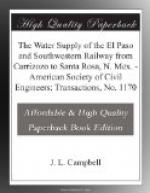Velocity in 16-in. pipe = 9.705
" " 10 " " = 3.791
Discharge of 16 " " = 5.292
" " 10 " " = 5.293
These last figures would check exactly, except for dropping figures in the fourth decimal place.
The results of these two tests, considering that 20 days elapsed between them, are in very close agreement, and establish the fact that bran is an accurate medium of measurement.
Test No 3.—The 500 ft. of 10-in. pipe in the 16-in. line near the reservoir (Fig. 2) were replaced by 16-in. pipe in the summer of 1908.
On May 12th, 1909, green aniline was started through the pipe at A at 11.00 A.M., 11.30 A.M., and 12.00 P.M. In each case it appeared at E in 3 hours and 31 min. This time is 20 min. less than that observed in the tests of the previous year, and is due to the removal of the 10-in. pipe from the 16-in. line and to the increasing smoothness of the interior surface of the pipe.
The relative velocities and discharges under the third test, using the nomenclature of the first and correcting the lengths of pipe on account of the removal of the 10-in. pipe near the reservoir, are:
48,000 + 12,700 ----- --------- = 12,660 x 2.56_x_
x = 4.183
and 2.56_x_ = 10.708
and the discharges are:
From the 10-in. pipe = 5.840 cu. ft. per sec.
" " 16 " " = 5.839 " " "
"
Coefficients.—On May 12th, 1909, the 10-in. line was working on a grade of 0.03338, and, with n = 0.009, C should have been 131. It was actually 138, making n = 0.00866. The 16-in. line was working on a grade of 0.0030625, and, with n = 0.009, C should have been 145. It was actually 141, making n = 0.0092.
Referring to the estimated hydraulic grade between Coyote and Corona (Plate V), the coefficients, 0.01 and 0.012, were used for wood and iron, respectively, on which basis, the maximum pressure at Coyote was expected to be 304 lb. and, at Luna, 310 lb. per sq. in. The actual maximum at Coyote, with pumps at full normal speed, was 270 lb., and, at Luna, 278 lb., indicating that the values of the coefficients taken were too high. This checks with the tests between Bonito and Nogal.
Of course, the iron pipe will increase in roughness, and, in time the pumping pressure will approach the calculated amount. The interior of the iron pipe now has a smooth coat of asphalt.
Pipe Breakage.—The breakage or damage to the wood pipe in shipment occurred on the ends, the tenons being most exposed to injury from shifting in the cars. The damage due to the shipment and handling of the Elmira pipe was 1% and one-half as much for the Bay City pipe. Less than 6 pieces out of 100,000 laid have had to be removed from the trench.
The iron pipe came from Chattanooga, and was badly handled in transit. Much of it was transferred en route, and 6% was broken when received. The breaks were generally cracks of the spigot end. Of this broken pipe, practically all was cut and laid. The average cut was about 16 in. from the spigot end of 533 pieces. This cut pipe has caused no trouble in the trench.




